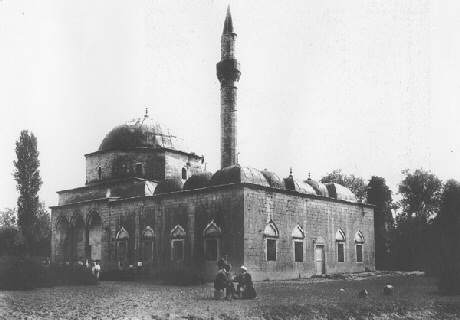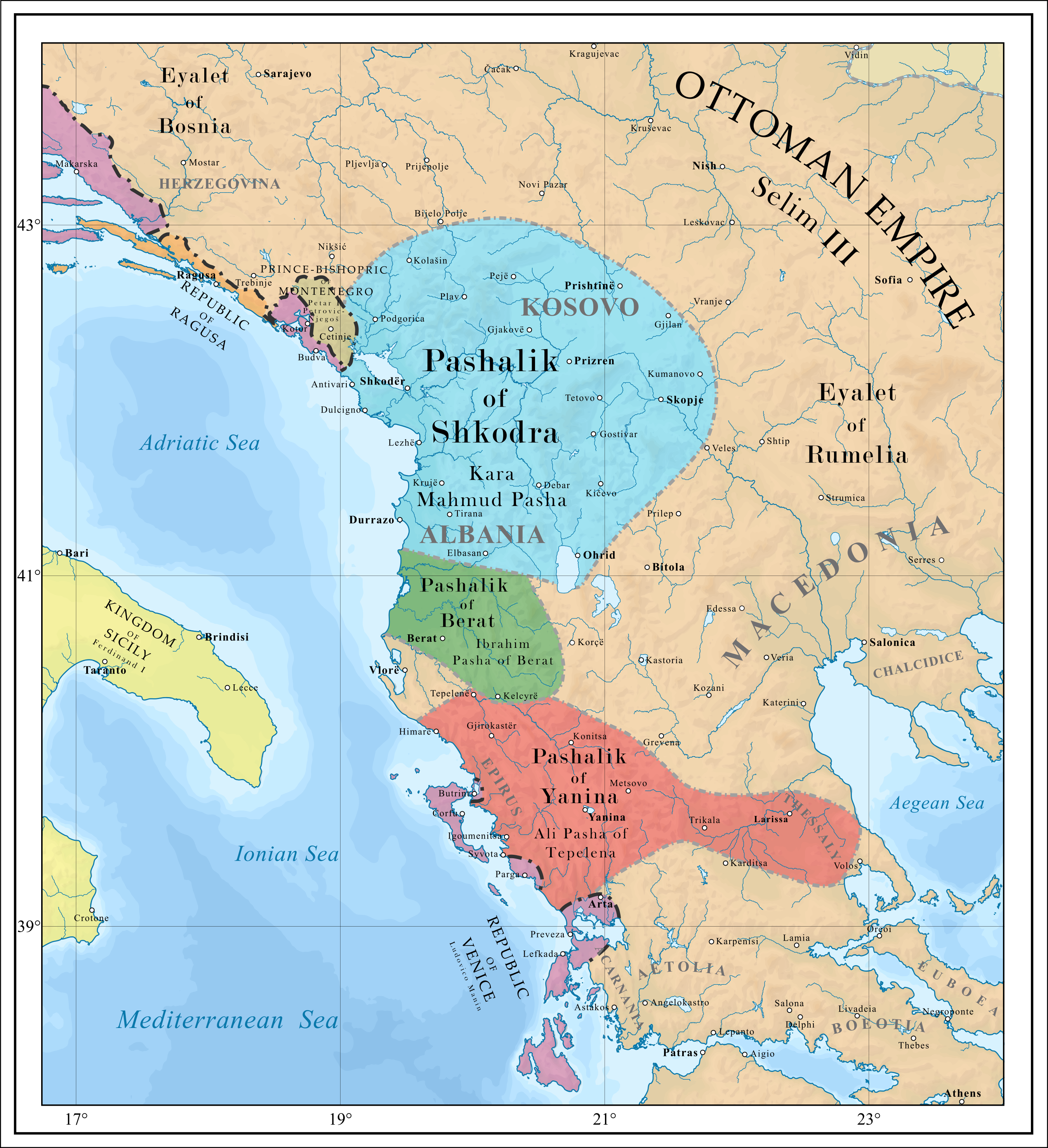|
Mehmed Bushati
Mehmed Pasha Bushati ( 1768–d. June 1775) was the Ottoman Albanian governor of the Pashalik of Scutari, between 1768 and June 1775. He was succeeded by his son Mustafa Pasha Bushati, and thus founded the hereditary Bushati family of Scutari. History Bushati was an Albanian Muslim clan leader. In 1768, Mehmed Pasha became the governor of the pashalik of Scutari. In 1769 he fought in Zadrima. In 1770 he fought in Morea against Greeks and Russians, and in 1772 he and his son participated in the march on Ulcinj. He continued the Scutari pretensions over Montenegro and Brda, and planned to suppress their revolt; in early April 1774, he was in Podgorica and met with some chieftains of the northern Albanian tribes to discuss the planned operation. In 1774, in the same month of the death of Šćepan Mali, he attacked the Kuči and Bjelopavlići Bjelopavlići ( cyrl, Бјелопавлићи; sq, Palabardhi), ) is a historical tribe (pleme) of Albanian origin and a valley in the ... [...More Info...] [...Related Items...] OR: [Wikipedia] [Google] [Baidu] |
Kara Mahmud Pasha
Kara Mahmud Pasha ( tr, Kara Mahmud Paşa, Albanian: Mahmud Pashë Bushati, 1749–22 September 1796) was a hereditary Ottoman Albanian governor (''mutasarrıf'') of the Pashalik of Scutari and de jure ruler of Albania, belonging to the Ottoman Albanian Bushati family. Life Mahmud was the son of Mehmed Pasha Bushati, the governor of the pashalik of Scutari. When Mehmed Pasha died in June 1775, the Sultan's rule was not returned to northern Albania; he was succeeded by his young son, Mahmud Pasha. Other important families were the Rotul dynasty, which ruled Prizren from the 1770s to 1836, and the Gjinolli family whose members ruled Prishtina and Gjilan (Srb.: Gnjil-ane), becoming so powerful in the early nineteenth century that they were called the 'second rulers' of Kosovo after the Sultan. In the late eighteenth century, however, there was just one local dynasty that could rival - and did in fact openly challenge - the Sultan: the Bushati or Bushatli family of Shkodra. ... [...More Info...] [...Related Items...] OR: [Wikipedia] [Google] [Baidu] |
Bushati Family
The Bushati family ( sq, Bushatllinjtë) was a prominent Ottoman Albanian family that ruled the Pashalik of Scutari from 1757 to 1831. Origins They are descendants of the medieval Bushati tribe, a pastoralist tribe (''fis'') in northern Albania and Montenegro. The name Bushat is compound of ''mbë fshat'' (''above the village''). This is a reference to them being pastoralists that weren't permanently settled. The Bushati started to settle permanently in the 15th century and this process had been completed in the late 16th century. Their settlement includes the village of Bushat in Shkodër in the Zadrima plain from where the Bushati family came. Another part settled with the tribe of Bukumiri in the would-be territory of the Piperi tribe, where they gradually became part of the new, larger tribe in the late 16th century. In the defter of 1497 they appear as ''katun Bushat'' in Piperi with 35 households. The Bushati family traces their origin to the Begaj brotherhood of Busha ... [...More Info...] [...Related Items...] OR: [Wikipedia] [Google] [Baidu] |
Sanjak Of Scutari
The Sanjak of Scutari or Sanjak of Shkodra ( sq, Sanxhaku i Shkodrës; sr, Скадарски санџак; tr, İskenderiye Sancağı or ''İşkodra Sancağı'') was one of the sanjaks of the Ottoman Empire. It was established after the Ottoman Empire acquired Shkodra after the siege of Shkodra in 1478–9. It was part of the Eyalet of Rumelia until 1867, when it became a part, together with the Sanjak of Skopje, of the newly established Scutari Vilayet. In 1912 and the beginning of 1913 it was occupied by members of the Balkan League during the First Balkan War. In 1914 the territory of Sanjak of Scutari became a part of the Principality of Albania, established on the basis of the peace contract signed during the London Conference in 1913. History Background and formation With short interruptions, the territory of northern Albania, including what would become the Sanjak of Scutari, belonged to the Serbian medieval states for many centuries. After the fall of the Ser ... [...More Info...] [...Related Items...] OR: [Wikipedia] [Google] [Baidu] |
Pasha
Pasha, Pacha or Paşa ( ota, پاشا; tr, paşa; sq, Pashë; ar, باشا), in older works sometimes anglicized as bashaw, was a higher rank in the Ottoman Empire, Ottoman political and military system, typically granted to governors, generals, dignitary, dignitaries, and others. As an honorific, honorary title, ''Pasha'', in one of its various ranks, is similar to a British Peerage of the United Kingdom, peerage or knighthood, and was also one of the highest titles in the 20th-century Kingdom of Egypt. The title was also used in Morocco in the 20th century, where it denoted a regional official or governor of a district. Etymology The English word "pasha" comes from Turkish language, Turkish ('; also ()). The Oxford Dictionaries (website), Oxford Dictionaries attributes the origin of the English borrowing to the mid-17th century. The etymology of the Turkish word itself has been a matter of debate. Contrary to titles like emir (''amīr'') and bey (''beg''), which were es ... [...More Info...] [...Related Items...] OR: [Wikipedia] [Google] [Baidu] |
Pashalik Of Scutari
The Pashalik of Scutari, Iskodra, or Shkodra (1757–1831), was an autonomous and ''de facto'' independent '' pashalik'' created by the Albanian Bushati family from the previous Sanjak of Scutari, which was situated around the city of Shkodër in modern-day Albania and large majority of modern-day Montenegro. At its peak during the reign of Kara Mahmud Bushati the pashalik encompassed much of Albania, most of Kosovo, western Macedonia, southeastern Serbia and most of Montenegro. Up to 1830 the Pashalik of Shkodra controlled most of the above lands including Southern Montenegro. Background The weakening of Ottoman central authority and the ''timar'' system of land ownership brought anarchy to the Albanian-populated region of the Ottoman empire. In the late eighteenth century, two Albanian centers of power emerged: Shkodër, under the Bushati family; and Janina, under Ali Pasha of Tepelenë. Both regions cooperated with and defied the Sublime Porte as their interests re ... [...More Info...] [...Related Items...] OR: [Wikipedia] [Google] [Baidu] |
Mustafa Pasha Bushati
Mustafa Pasha Bushatli ( tr, Mustafa Paşa Buşatlı, 1797 – May 27, 1860), called ''Işkodralı'' ("from Scutari"), was a semi-independent Albanian Ottoman statesman, the last hereditary governor of the Pashalik of Scutari. In 1810 he succeeded Ibrahim Bushati and ruled Scutari until 1831. History Mustafa was the brother of the powerful Kara Mahmud Bushatli. He succeeded his uncle, Ibrahim Pasha in 1810 and received the rank of Vizier in 1812 and continued to rule the Pashaluk of Shkodra as an independent ruler. In 1820, the sanjak of Berat was appropriated to him. Mustafa led a mercenary army in the early stages of the Greek War of Independence. In 1823 a campaign of 8,000 Albanian troops (according to Finlay), in Western Greece was led by Mustafa Pasha and Omer Vrioni; On August 24, 1823, Markos Botsaris and 350 Souliotes attacked the army of Mustafa Pasha near Karpenisi, attempting to stop the Ottoman advance. The battle ended in Ottoman defeat, and Botsaris was kille ... [...More Info...] [...Related Items...] OR: [Wikipedia] [Google] [Baidu] |
Šćepan Mali
Šćepan Mali ( sr-cyr, Шћепан Мали ), translated as Stephen the Little, Stephen the Small or Stephen the Humble, ( – 22 September 1773) was the first and only "tsar" of Montenegro, ruling the country as an absolute monarch from 1768 until his death. Of unclear origins, Šćepan became the ruler of Montenegro through a rumour that he was in fact the deposed Russian emperor Peter III, who had died several years before Šćepan surfaced in the Balkans. Šćepan arrived in Montenegro in the autumn of 1766. Whether Šćepan was his real name is unknown, as is the reason for the epithet ''Mali''. Who started the rumour that Šćepan was Peter and why is also unclear. Šćepan himself never formally proclaimed himself to be Peter, but never denied it either. Throughout 1767, he offered vague hints that he was the dead emperor, and as time went on, most of Montenegro became convinced of his supposed identity. Although Montenegro's legitimate ruler, Prince-Bishop Sava, who h ... [...More Info...] [...Related Items...] OR: [Wikipedia] [Google] [Baidu] |
Bjelopavlići
Bjelopavlići ( cyrl, Бјелопавлићи; sq, Palabardhi), ) is a historical tribe (pleme) of Albanian origin and a valley in the Brda region of Montenegro, around the city of Danilovgrad. Geography The ''Bjelopavlići'' valley (also known as the Zeta river valley) is a strip of fertile lowland stretching along the Zeta river, being wider in the river's lower end, down to the confluence with Morača river near Podgorica. The valley has historically been densely populated, as fertile lowlands are rare in mountainous Montenegro, and it provided a corridor for road and rail connection between the two biggest Montenegrin cities, Podgorica and Nikšić. The largest settlement in the plain is the town of Danilovgrad which got name by Prince (Knjaz) Danilo Petrović. Confusingly, the other significant plain in Montenegro, Zeta plain has been named after Zeta river, although Zeta river itself does not flow through it. Origins Originally an Albanian tribe, the Bjelopavlići und ... [...More Info...] [...Related Items...] OR: [Wikipedia] [Google] [Baidu] |
Kuala Lumpur
, anthem = '' Maju dan Sejahtera'' , image_map = , map_caption = , pushpin_map = Malaysia#Southeast Asia#Asia , pushpin_map_caption = , coordinates = , subdivision_type = Country , subdivision_name = , subdivision_type1 = Administrative areas , subdivision_name1 = , established_title = Establishment , established_date = 1857 , established_title2 = City status , established_date2 = 1 February 1972 , established_title3 = Transferred to federal jurisdiction , established_date3 = 1 February 1974 , government_type = Federal administrationwith local government , governing_body = Kuala Lumpur City Hall , leader_title = Mayor , leader_name = Mahadi bin Che Ngah , total_type = Federal territory , area_footnotes = , area_total_km2 = 2 ... [...More Info...] [...Related Items...] OR: [Wikipedia] [Google] [Baidu] |
18th-century People From The Ottoman Empire
The 18th century lasted from January 1, 1701 ( MDCCI) to December 31, 1800 ( MDCCC). During the 18th century, elements of Enlightenment thinking culminated in the American, French, and Haitian Revolutions. During the century, slave trading and human trafficking expanded across the shores of the Atlantic, while declining in Russia, China, and Korea. Revolutions began to challenge the legitimacy of monarchical and aristocratic power structures, including the structures and beliefs that supported slavery. The Industrial Revolution began during mid-century, leading to radical changes in human society and the environment. Western historians have occasionally defined the 18th century otherwise for the purposes of their work. For example, the "short" 18th century may be defined as 1715–1789, denoting the period of time between the death of Louis XIV of France and the start of the French Revolution, with an emphasis on directly interconnected events. To historians who expand ... [...More Info...] [...Related Items...] OR: [Wikipedia] [Google] [Baidu] |





